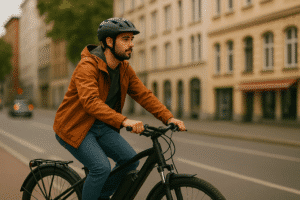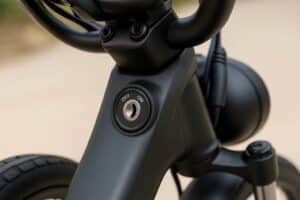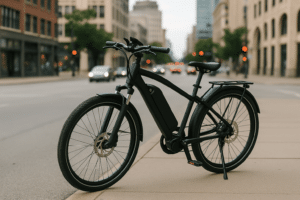Electric bikes are more popular than ever, but the rules can be confusing. Michigan e-bike laws explain where you can ride, which classes are recognized, and what safety requirements apply.
Knowing these laws helps you ride with confidence and avoid tickets.
Michigan E-Bike Laws at a Glance
- Michigan recognizes three e-bike classes: Class 1 (pedal-assist, 20 mph), Class 2 (throttle or pedal assist, 20 mph), and Class 3 (pedal-assist, 28 mph).
- No license, registration, or insurance is required to ride an e-bike.
- Class 1 e-bikes can use most paved or gravel state-managed trails open to bicycles.
- Class 2 e-bikes need a free DNR mobility permit for trail access beyond roads and bike lanes.
- Class 3 e-bikes are limited to roads and bike lanes and require riders to be at least 14 years old.
- Helmets are required for Class 3 riders aged 14–18, but not for Class 1 or 2.
Are E-Bikes Legal in Michigan?
Yes, e-bikes are legal in Michigan. The state recognizes three classes of electric bikes, and they are generally treated the same as traditional bicycles on most roads and bike lanes.
Michigan law allows Class 1, 2, and 3 e-bikes on city streets, county roads, and highways where regular bikes are permitted. However, trail access is more limited.
Class 1 bikes can use most state-managed trails, while Class 2 requires a permit in some cases, and Class 3 is restricted from natural-surface non-motorized trails. Local governments can also set additional rules, so it’s smart to check city or county ordinances before heading out.
This framework makes Michigan one of many states that follow the national 3-class e-bike system, giving riders clarity on speed limits, age rules, and helmet requirements.
Michigan E-Bike Definition and Requirements
Michigan law defines an e-bike as a bicycle with a motor of 750 watts (1 horsepower) or less, fully operational pedals, and a seat or saddle.
To qualify as an e-bike in Michigan, it must:
- Have pedals that work at all times.
- Include a permanent label showing the correct class.
- Use an electric motor no larger than 750 watts.
- Not exceed 20 mph for Class 1 and 2, or 28 mph for Class 3.
If the bike is modified, a new class label must be attached that reflects its updated status.
Where Can You Ride an E-Bike in Michigan?
E-bike access depends on the class of bike and the type of trail or roadway. Here’s a breakdown of where you can and cannot ride.
Allowed on:
- All public roads, streets, highways, and road shoulders.
- Bike lanes and shared-use paths open to bicycles.
- Improved-surface state-managed trails (Class 1 only; Class 2 with mobility permit).
- Motorized natural-surface trails, such as ORV trails.
Not allowed on:
- State game and wildlife areas.
- Non-motorized, natural-surface trails (unless authorized).
- Congressionally authorized trails like the North Country Trail.
- Sidewalks (unless a local ordinance permits it).
- Mackinac Island, unless you have a mobility permit.
- Private property, without the owner’s permission.
Age and Helmet Requirements
Michigan sets different rules depending on the class of e-bike. There is no minimum age for riding Class 1 or Class 2 bikes, which makes them accessible to younger riders and families.
However, Class 3 bikes, which can reach speeds of up to 28 mph, require the rider to be at least 14 years old.
Helmet laws also vary by class. Riders between the ages of 14 and 18 must wear a helmet when operating a Class 3 bike.
Helmets are not legally required for Class 1 or 2 riders, but safety experts strongly recommend wearing one regardless of class, especially given the higher speeds and traffic interactions that come with e-biking.
These rules are designed to balance accessibility with safety, recognizing that faster bikes carry greater risks.
Do You Need a License or Registration to Ride an E-Bike in Michigan?
No, you do not need a driver’s license, registration, or insurance to ride an e-bike in Michigan. They are regulated under bicycle laws rather than motor vehicle laws.
This makes e-bikes easy to use compared to mopeds or scooters, which often require licensing. Riders only need to follow the same traffic laws as cyclists, such as stopping at stop signs, signaling turns, and yielding to pedestrians.
What About E-Bike Classes in Michigan?
Michigan follows the nationwide 3-class system for electric bikes. Each class has its own limits and permissions.
- Class 1: Pedal-assist only, with motor support up to 20 mph. Motor stops when pedaling stops.
- Class 2: Throttle and pedal assist, with motor support up to 20 mph. Can operate without pedaling.
- Class 3: Pedal-assist only, with motor support up to 28 mph. Rider must be at least 14 years old, and helmets are required for teens.
E-Bikes in Michigan State Parks and Forests
Michigan recently updated its laws to expand e-bike access on state-managed trails. Class 1 e-bikes are now allowed on many improved-surface trails, including paved or gravel linear trails in state parks, recreation areas, and state forest pathways.
This means riders can enjoy popular routes like rail trails and other long-distance paths.
Class 2 e-bikes are more restricted. They are only permitted on these same trails if the rider has a DNR-issued mobility permit (free of charge). Without the permit, Class 2 bikes are not allowed on natural-surface nonmotorized trails.
Class 3 e-bikes remain the most limited. They are not permitted on any state-managed nonmotorized trails, regardless of surface type.
Some key restrictions include:
- E-bikes are not allowed in state game and wildlife areas.
- They are banned on congressionally authorized trails such as the North Country Trail.
- Specific trail segments in Pigeon River Country (High Country, Shingle Mill, and Pickerel Lake pathways) are off-limits.
These rules aim to balance accessibility for riders with the protection of natural resources and the experience of traditional trail users like hikers and mountain bikers.
Read more:
Final Words
Michigan e-bike laws are fairly straightforward once you understand the three-class system. All e-bikes can be ridden on public roads and bike lanes, while trail access depends on the class and location.
Class 1 has the most flexibility, Class 2 needs a mobility permit for certain trails, and Class 3 is limited to roads and paved paths.
The state does not require licensing, registration, or insurance, but it does set age and helmet rules for faster bikes.
Local ordinances can add extra restrictions, so it’s always worth checking before you ride.
By knowing these basics, you can enjoy Michigan’s growing network of bike lanes, paths, and trails with peace of mind.
FAQs
Are Class 3 e-bikes legal in Michigan?
Yes, Class 3 e-bikes are legal on roads and bike lanes, but they are not allowed on nonmotorized trails. Riders must be at least 14 years old, and helmets are required for ages 14–18.
Can I ride an e-bike on sidewalks in Michigan?
Generally, no. E-bikes are not allowed on sidewalks unless a local ordinance specifically permits it.
Are there speed limits for e-bikes in Michigan?
Yes. Class 1 and Class 2 e-bikes are limited to 20 mph with motor assistance, while Class 3 can provide assist up to 28 mph. Riders must still obey posted speed limits when on roads.
Can kids ride e-bikes in Michigan?
Children can ride Class 1 and 2 e-bikes, since there is no minimum age. For Class 3 bikes, the rider must be at least 14 years old.
Al Amin Morshed is the founder of BoltBikers and a seasoned e-bike reviewer with years of hands-on experience testing electric bikes. As a long-time e-bike enthusiast, he combines real-world riding insights with in-depth research to create honest, helpful content for riders of all levels. Through BoltBikers, Morshed aims to make e-biking more accessible, practical, and enjoyable – whether you’re a new rider or a daily commuter looking for the best gear.








